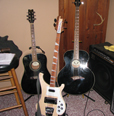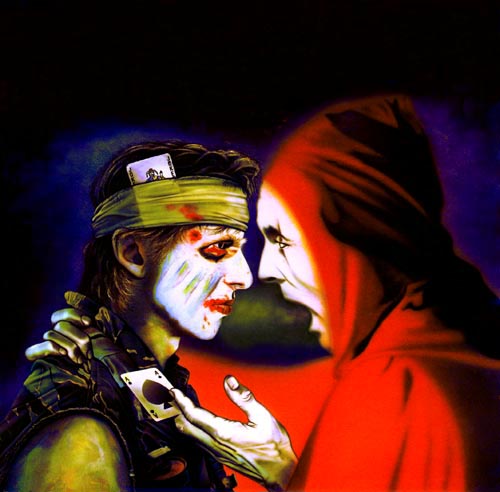| Author |
 Topic Search Topic Search  Topic Options Topic Options
|
goose 
Forum Senior Member


Joined: June 20 2004
Location: United Kingdom
Status: Offline
Points: 4097
|
 Posted: March 24 2005 at 06:30 Posted: March 24 2005 at 06:30 |
 penguindf12 wrote: penguindf12 wrote:
Okay...I'm confused...
Alright. So I get the top digit: it's the number of beats per measure. But the bottom number confuses me. I know it's the "note which gets the beat". But how do you distinguish when counting? Like in "Money." How can you tell it's 7/4 and not 7/8 or 7/16 or 7/32 or 7/128 for that matter? How do you know?! And what's the difference between "one bar of 3/4 and one bar of 4/4" and one bar of 7/4 (or 7/8 or 7/16 or 7/32 etc.)?!!!!
Please clue me in here...
|
In general, the difference between 7/4 and 7/8 is one of feel (it can also depend on what the pulse has been in the bars before or after, ie. going from 4/4 to 7/4 the bars are nearly twice as long, wheras going from 4/4 to 7/8 they're slightly shorter.
Traditionally, 7/4 should be divided into 7 crotchets, perhaps with quavers between or anything like that. 7/8, on the other hand, is a compound time and should be divided into 3s (3,3,1 or 3,2,2) but again, these are only guidlines. Venturing into 7/16 and so on has a different feel again but since prog doesn't really follow the traditional timings there's not much point in cluttering the page with 64s and 128s all over the place.
The difference between 3/4 + 4/4 and 7/4 can be nothing, but the former expresses the accents (ie. on the first beat of each bar) much more explicitly, wheras 7/4 can be divided up in any number of ways.
A mention has to go to "A headache and a 64th", by Ron Jarzombek (of Spastic Ink/Watchtower), which has a 4/4 bar followed by a 1/64 bar (in effect, 65/64). It's really really irritating listening to because it just falls slightly later than you'd expect.
|
 |
goose 
Forum Senior Member


Joined: June 20 2004
Location: United Kingdom
Status: Offline
Points: 4097
|
 Posted: March 24 2005 at 06:23 Posted: March 24 2005 at 06:23 |
 kingofbizzare wrote: kingofbizzare wrote:
That isn't always accurate. For example, 6/8 can sound like 2/4 with triplets (or vice versa)
Then you get interesting things like 17/16...
|
If it sounds like 2/4 then you can call it 2/4. It doesn't really matter what the player/listener considers it as, as long as it's played with the right feel. What was written on the page (assuming there is one) is only a guide to how to play it (especially if there's a 3 against 2 crossrhythm, that way there's no definite answer). But in general, if there are triplets all the way through it's unlikely to sound like 2/4 anyway.
|
 |
Certif1ed 
Special Collaborator


Honorary Collaborator
Joined: April 08 2004
Location: England
Status: Offline
Points: 7559
|
 Posted: March 24 2005 at 03:40 Posted: March 24 2005 at 03:40 |
 penguindf12 wrote: penguindf12 wrote:
Okay...I'm confused...
Alright. So I get the top digit: it's the number of beats per measure. But the bottom number confuses me. I know it's the "note which gets the beat". But how do you distinguish when counting? Like in "Money." How can you tell it's 7/4 and not 7/8 or 7/16 or 7/32 or 7/128 for that matter? How do you know?! And what's the difference between "one bar of 3/4 and one bar of 4/4" and one bar of 7/4 (or 7/8 or 7/16 or 7/32 etc.)?!!!!
Please clue me in here...
|
Generally, anything over 4 is "simple" time, and you just count the numbers. E.g; "Money" is in 7/4, so you just count 7 crotchet beats per bar - until the bit where it changes to 4/4.
Equally generally, anything over 8 is compound time, meaning that you count dotted crotchet beats while hearing effective triplets between the beats. Hence with 6/8, you count 2 dotted crotchets per bar.
/16 time is more difficult to gauge, as there are more permutations - generally the music will be broken into little chunks of 2s and 3s. Typically, music in this sort of time originates from the Balkans, where the frenetic dance music could only be recorded using Western notation using finer granularity than /8. The beats tend to be incredibly quick, as they are counted in semiquavers.
Then we get into the more complex time signatures demanded by Indian music and the polyrhythms of Salsa... but it can all be broken down into 2s and 3s.
Hope that gives at least one clue!
Edited by Certif1ed
|
 |
Soulman 
Forum Senior Member

Joined: January 22 2005
Status: Offline
Points: 290
|
 Posted: March 24 2005 at 02:37 Posted: March 24 2005 at 02:37 |
I'm gonna take the chance to say.
MY GOSH PROG IS AWESOME!!!

|
 |
Soulman 
Forum Senior Member

Joined: January 22 2005
Status: Offline
Points: 290
|
 Posted: March 24 2005 at 02:35 Posted: March 24 2005 at 02:35 |
^^
Yea I'm about as confused as you 
I can't really tell you how you can notice. Sometimes you just have to
count the beats (mostly listening to the drums and a little bit of the
melody playing), and it won't always make sense to go "1 and 2 and 3
and 4 and" in some parts of prog songs, it just won't work with the
melody all the time, as the measure probably wouldn't end on a bad
note.
You've got to think how it would look on paper. Yes you could write any
song in 4/4 on paper; though it wouldn't make sense to the melody and
the drummer who's keeping the rhythm. Time signatures are just
restrictions to measures.
Just listen a bit more, you might get it. Though I think practice will help you understand it more.
However, I kind of doubt that a lot of prog songs are going to be 7/8
or 9/16; it's just too bloody difficult for the drummer to follow that
kind of rhythm (though I applaud artists that can do so   .)
As I said, it'd probably make more sense when you think of how score of the piece would look on paper.
|
 |
penguindf12 
Prog Reviewer


Joined: September 20 2004
Location: United States
Status: Offline
Points: 831
|
 Posted: March 23 2005 at 22:23 Posted: March 23 2005 at 22:23 |
Okay...I'm confused...
Alright. So I get the top digit: it's the number of beats per measure. But the bottom number confuses me. I know it's the "note which gets the beat". But how do you distinguish when counting? Like in "Money." How can you tell it's 7/4 and not 7/8 or 7/16 or 7/32 or 7/128 for that matter? How do you know?! And what's the difference between "one bar of 3/4 and one bar of 4/4" and one bar of 7/4 (or 7/8 or 7/16 or 7/32 etc.)?!!!!
Please clue me in here...
|
 |
kingofbizzare 
Forum Senior Member


Joined: March 09 2005
Location: United States
Status: Offline
Points: 520
|
 Posted: March 23 2005 at 22:09 Posted: March 23 2005 at 22:09 |
 Soulman wrote: Soulman wrote:
Although I hear about time signature like 17/16. Whoa-ho! That would be
hard to figure out. Though I figure if you listen to the drums and the
riffs, then you kind of start to get the idea. |
My friend wrote some stuff that had random bars of 17/16 thrown in with
4/4. It was pretty messed up, it sounded like 4/4 with an extra 16th
note stuck in at the end. It really threw off your counting if you
didn't know it was coming.
|
 |
Certif1ed 
Special Collaborator


Honorary Collaborator
Joined: April 08 2004
Location: England
Status: Offline
Points: 7559
|
 Posted: March 23 2005 at 17:13 Posted: March 23 2005 at 17:13 |
The more elaborate ones are fairly hard to get if you're not used to it - but practice does make perfect.
2/4 is very rarely used, and, as was pointed out above, 6/8 sounds like 2/4 but with triplets - that's because the 6 quavers pulse in 2 groups of three - the beat is actually a dotted crotchet (three quavers) - it's the same for any piece in compound time (anything /8 is in compound time).
Most pieces I've heard in more complex time signatures tend to cheat - in 7/4, for example, you'll hear musicians play a "bar" of 4 then a bar of 3, because it makes counting easier. Very few, like "Money" are truly in 7 time. 7/8 is very rare indeed, and should sound like 2 and a third, but typically sounds more like 3 and a half beats - which is 7/4, of course.
I'm really not sure about anything in /16 time - I rather think it's showing off. Some of the great composers used similar time signatures - like Stravinsky - but typically only for a few bars in a piece (e.g. the Rite of Spring). Usually clusters of bars in what appear to be freaky time signatures appear, when the composer could simply have stuck a few extra accents in there - for example, Stravinsky sticks a few bars of 3/4 in between some bars of 6/8, then in another passage [110] we see 2 bars of 5/8, then one each of 7/8, 5/8, 3/8, 3/4, 3/8, 4/4, 3/8.
Unless you were looking at the score, you'd never count that lot - but you'd be forgiven for thinking the whole thing was in 9/8.
|
 |
synthguy 
Forum Senior Member


Joined: February 25 2005
Location: United States
Status: Offline
Points: 225
|
 Posted: March 23 2005 at 15:55 Posted: March 23 2005 at 15:55 |
 Soulman wrote: Soulman wrote:
Hello again,
Something has been plaguing my mind about prog. How in
the heck do you
tell what time signature some prog songs are in? I'm just
confused how
you can figure out these abstract time signatures by just
hearing it.

|
If you own one, try a metronome.
Me, I'm counting out time.
Che
|
|
Wearing feelings on our faces when our faces took a rest...
|
 |
Soulman 
Forum Senior Member

Joined: January 22 2005
Status: Offline
Points: 290
|
 Posted: March 23 2005 at 04:30 Posted: March 23 2005 at 04:30 |
I've tried trying to figure what parts of the songs are in what time
signatures. I think I kind of got it while listening to Spock's Beard
"The Great Nothing"  .
Although it is hard to tell the difference between 6/8 and 3/4 and 12/8
and 4/4 because counting the time can sound the same. Although due to
musical notation, they are labelled 6/8 or 12/8 because of the style of
music; 12/8 namely being swing and blues.
Although I hear about time signature like 17/16. Whoa-ho! That would be
hard to figure out. Though I figure if you listen to the drums and the
riffs, then you kind of start to get the idea.
However, confusing this topic is, it would seem mostly relevant to the
artist. Although it never stopped us listeners/musicians from looking
at the technical aspects of the songs.
|
 |
Guests 
Forum Guest Group

|
 Posted: March 22 2005 at 21:43 Posted: March 22 2005 at 21:43 |
Personally, I think this is one of the most definitive elements of Progressive Rock Music...
the shifting time signatures, in addition to stuff like change-ups in instrumentation, etc.
BTW, I thought 6/8 resembles 3/4 (not arguing the point, just curious OK  ) )
|
 |
kingofbizzare 
Forum Senior Member


Joined: March 09 2005
Location: United States
Status: Offline
Points: 520
|
 Posted: March 22 2005 at 18:10 Posted: March 22 2005 at 18:10 |
 goose wrote: goose wrote:
Assuming it stays in the same time signature for a few
bars, it isn't difficult once one gets used to it. As long as you can
hear where each bar begins, then you just need to count the main beats
between. It's when every bar's in a different time signature it starts
to get tricky... |
That isn't always accurate. For example, 6/8 can sound like 2/4 with triplets (or vice versa)
Then you get interesting things like 17/16...
|
 |
goose 
Forum Senior Member


Joined: June 20 2004
Location: United Kingdom
Status: Offline
Points: 4097
|
 Posted: March 21 2005 at 17:56 Posted: March 21 2005 at 17:56 |
|
Assuming it stays in the same time signature for a few bars, it isn't difficult once one gets used to it. As long as you can hear where each bar begins, then you just need to count the main beats between. It's when every bar's in a different time signature it starts to get tricky...
|
 |
clemdallaway 
Forum Newbie

Joined: February 06 2005
Location: United Kingdom
Status: Offline
Points: 33
|
 Posted: March 21 2005 at 13:26 Posted: March 21 2005 at 13:26 |
Try listening to the beat and then counting the notes!!!!!!!!!!
|
|
Don't eat the yellow snow!!!!!
|
 |
Cygnus X-2 
Special Collaborator


Honorary Collaborator
Joined: December 24 2004
Location: Bucketheadland
Status: Offline
Points: 21342
|
 Posted: March 20 2005 at 17:18 Posted: March 20 2005 at 17:18 |
I have the same problem...
|
|
|
 |
Soulman 
Forum Senior Member

Joined: January 22 2005
Status: Offline
Points: 290
|
 Posted: March 20 2005 at 17:11 Posted: March 20 2005 at 17:11 |
Hello again,
Something has been plaguing my mind about prog. How in the heck do you
tell what time signature some prog songs are in? I'm just confused how
you can figure out these abstract time signatures by just hearing it. 

|
 |
Donate monthly and keep PA fast-loading and ad-free forever.
/PAlogo_v2.gif)


